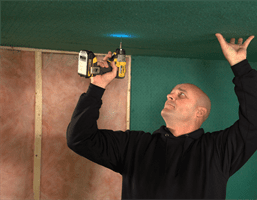
Increase your home’s liveable space and value
For much of the past year, most Canadians have spent more time than usual at home where some have discovered that their family needs more space. A basement renovation is one of the most popular home renovations. It not only provides more usable living space but also greatly increases home value.
Whether the plan is to use the space as a family recreation room, media room, or home office, soundproofing should be a key component of the reno. Soundproofing is often overlooked because unlike flooring or choice of paint colour, it’s not visible once the construction is complete.
Soundproofing is an effective and cost-efficient way to ensure the peace and comfort of family members upstairs and downstairs. The cost of soundproofing for the average basement costs less than $1000 but it makes a huge difference in the enjoyment of your home.
Bryan Baeumler, HGTV host and professional contractor, knows all about basement renovations and believes soundproofing should be part of every project.
“The right soundproofing solution is especially important for basement renos since it needs to serve two purposes: providing the best possible sound quality inside the room and limiting noise transfer to and from the rest of the house.”
Baeumler suggests using Sonopan with NoiseStop Technology. The panels are lightweight, simple to install behind drywall and environmentally friendly because they’re made from 100 per cent recycled wood and are 100 per cent recyclable.
“It’s the best possible, most cost-effective soundproofing option,” says Baeumler. “It absorbs a wide range of frequencies and significantly reduces the transmission of sound and vibrations. The panels are lightweight, simple to install behind drywall, and can be installed by a contractor or you can do it yourself. Because they contain no added formaldehydes or VOCs (volatile organic compounds), there isn’t a negative impact on in-home air quality.”
He says when installing a drop ceiling in a basement, install soundproofing first. It’s important to create a solid barrier to stop sound. Although certain tiles can do a decent job absorbing sound, much of the noise still travels through the tracks. Seal any gaps with acoustical caulking and adding insulation batts can be used to increase soundproofing value.
While soundproofing is most easily addressed in new construction, when applying over an existing wall, follow the normal installation procedure. Make sure screws are long enough to secure panels into framework and then add drywall as usual.
Soundproofing can help ensure that you’re making the best use of your available space and protects the investment in your home.
credit – newscanada.com

Leave A Comment
You must be logged in to post a comment.